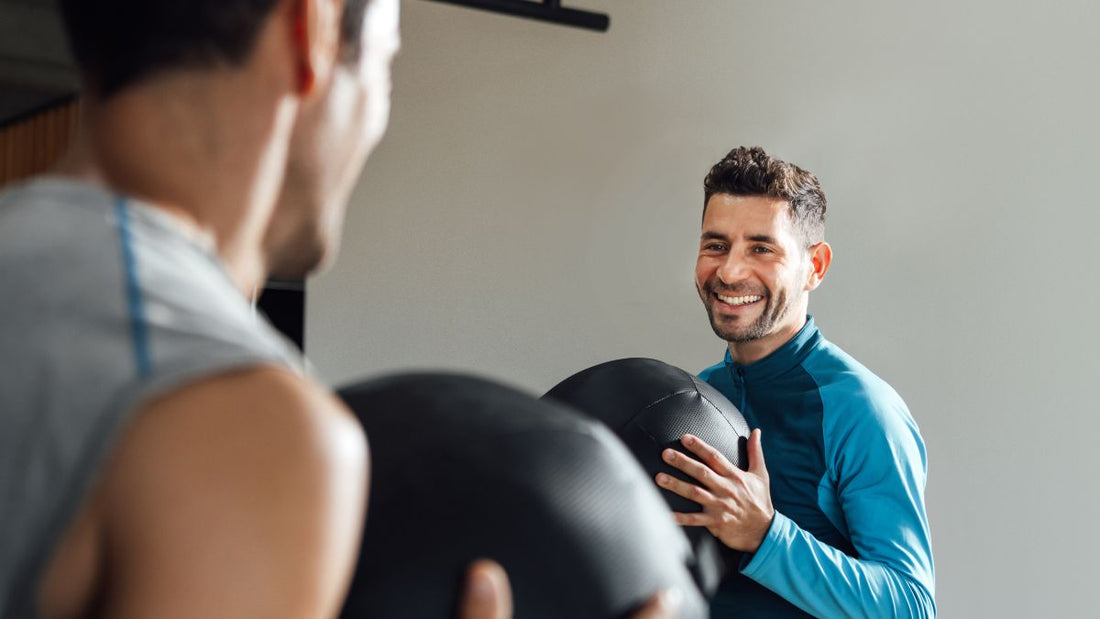By James Davis, Psychologist/Life Coach/ co-creator of Midlife Mentors
Few of us head into our 40s and 50s expecting to be the same shape and weight we were at 25. But whilst it can be generally harder to maintain muscle tone or lose weight as you get older it is not an inevitable side effect of mid-life. The truth is as we hit our 40s and 50s we tend to be less active but with the right type of regular exercise (and diet) you can not only improve your health and fitness, keep your weight down and significantly improve muscle mass in midlife but you can also mitigate common symptoms of andropause, a condition linked to ageing and low testosterone, symptoms of which include muscle degeneration and changes to body composition (making you more likely to acquire a gut and possibly ‘moobs’). Significantly too, exercise should not only help to increase and preserve your testosterone levels and induce human growth hormone1 (described by some as the key to slowing the ageing process) but it can also help you combat the fatigue linked to andropause, improve sexual function, help you manage stress, get better sleep and improve psychological function. So, what are the most effective ways of exercising for managing andropause symptoms and/or outrunning muscle degeneration, weight gain and lethargy in midlife?
Resistance training
There is clear evidence to show that resistance training raises testosterone2 and that the increase continues even after you have finished training. This type of exercise can include lifting free weights, using weight machines or resistance bands and/or performing exercises that use your own bodyweight such as squats or pull-ups. Resistance exercise also helps to support and maintain lean muscle mass which in turn helps to boost your metabolism - the rate at which your body breaks down food and turns it into energy - something that tends to slow down in older adults.3 As we age we are also more at risk of sarcopenia4 , a progressive loss of muscle mass and strength which is said to affect around 10% of adults over 5055 and is linked to changes in hormone levels, being increasingly sedentary and nutritional deficiencies (such as vitamin D and not eating enough muscle-building protein).6 Adjusting your diet and moving more can, however, help prevent, or reverse it and resistance exercise appears to be the most direct way to increase muscle mass and prevent it degenerating (although even fast walking regularly has been shown to reduce the risk of sarcopenia).7 Ideally, aim for two sessions of strength training a week.
High Intensity Interval Training (HIIT)
High Intensity Interval Training (HIIT) as its name suggests, involves short high intensity bursts of exercise alternated with periods of low intensity exercise or rest. This type of activity provides the benefits of regular exercise but in less time. It should quickly raise your heart rate, target all major muscle groups, help to burn calories fast and reduce body fat8 . Research has shown that HIIT burns around 25-30% more calories than other forms of exercise9 and several studies have shown after doing a HIIT work-out your metabolism increases for hours afterwards, even when you are resting10 One small study even suggests regular HIIT training could reduce your biological age11. On top of this, it has also been shown that HIIT can help improve blood sugar levels and insulin sensitivity12 – when your body cannot effectively regulate blood sugar levels, a risk factor for developing type 2 diabetes. There are lots of different HIIT exercises that you can do including quick sprints outdoors or on a treadmill, using a stationary bike, push ups and skipping. The other benefit to HIIT, in our time-strapped lives, is that it is a quick work-out - 20 minutes is generally an effective amount of time to achieve good results although if you can work up to 40 minutes’ worth you will achieve even more beneficial effects. Ideally, aim to do a couple of HIIT work-outs a week.
Moderate-intensity Cardio
Moderate-intensity cardio, or cardiovascular exercise (such as running, cycling, swimming, jogging, hiking) is important for general well-being, weight management and heart health. (Age-related declines in testosterone are associated with an increased risk of heart disease.13 ) Also known as aerobic or endurance exercise, cardio is sustained activity that raises your heartbeat, gets your blood pumping, helps burn fat, increases endurance and helps to build stronger, healthier bones.14 Cardio exercise (along with resistance training) can also help boost collagen production. Collagen levels naturally deplete with age and with less of it your joints might not move as smoothly and efficiently as they should. Exercise, however, nourishes the fibroblast cells in your skin helping to support and maintain collagen in your joints, tendons and connective tissue. On top of this, most moderate-intensity cardio exercise is also usually pleasurable, and by doing some form of physical activity you actively enjoy, you are more likely to stick with it and do it regularly.
It is generally recommended that you do 150 minutes a week of moderate-intensity cardio exercise but that can be broken down into more manageable 30 minute slots over five days.
Flexibility training
Flexibility training exercise such as yoga, Pilates, Tai Chi or warm up and cool down stretches done before and after exercising can help to improve your posture and balance, reduce joint aches, pains and stiffness plus help to prevent common injuries like muscle strain and backache. Becoming increasingly flexible should also lead to a better range of movement in your joints. Focusing on flexibility should also help increase bone density (basically bone strength), improve your balance and make you less prone to falls (if your bone density becomes compromised you are more likely to break or fracture bones if you fall). Loss of bone density also puts you more at risk of osteoporosis (brittle and fragile bones). Whilst this is a condition often associated with post-menopausal women (and it does affect one in three 50-plus women) one in five men over 50 are also affected.15
The key to flexibility training is to do it regularly. Ideally, do a short routine of stretches every day but at least three or four times a week.
Rest and recovery time
Whilst not a type of exercise in itself, recovery time is an important part of any exercise routine as it allows your body to repair muscle tissue and release hormones that support muscle growth. At rest, you give your muscles the chance to heal and grow back stronger. This is why it is important to leave at least 48 hours between working out the same muscle groups. If your muscles feel constantly sore and you never seem to recover from your work-outs you are probably over-training. Overexerting yourself can also be counter productive as research shows that elite athletes (and even overenthusiastic amateurs) who push themselves too hard tend to have lower testosterone levels.16 Over-exercising appears to push up levels of the stress hormone cortisol which can lead to an imbalance of testosterone. Plus cortisol causes the body hold onto fat, especially around the abdomen.
** Speak to your GP first if you have not exercised for a long time and/or you have diagnosed medical conditions or concerns. If you are a beginner make sure the type of exercise and intensity is appropriate for you and your fitness level. Start with regular walks and then slowly build up to more..
References
1. https://www.healthline.com/nutrition/11-ways-to-increase-hgh
2. https://pubmed.ncbi.nlm.nih.gov/2796409/
3. https://pubmed.ncbi.nlm.nih.gov/34385400/
4. https://www.topdoctors.co.uk/medical-dictionary/sarcopenia
5. https://www.ncbi.nlm.nih.gov/pmc/articles/PMC5434551/
6. https://pubmed.ncbi.nlm.nih.gov/22338070/
7. https://pubmed.ncbi.nlm.nih.gov/25782425/
8. https://pubmed.ncbi.nlm.nih.gov/25581765/
9. https://pubmed.ncbi.nlm.nih.gov/25162652/
10. https://journals.plos.org/plosone/article?id=10.1371/journal.pone.0189590
11. https://www.ncbi.nlm.nih.gov/pmc/articles/PMC10265161/
12. https://pubmed.ncbi.nlm.nih.gov/26481101/
13. https://www.ncbi.nlm.nih.gov/pmc/articles/PMC5512682/
14. https://munewsarchives.missouri.edu/news-releases/2009/0226-hinton-bone-density.php.html
15. https://www.osteoporosis.foundation/health-professionals/about-osteoporosis/epidemiology#:~:text=Osteoporosis%20is%20a%20major%20non,age%20of%2050%20worldwide%20%5B1%5D
16. https://pubmed.ncbi.nlm.nih.gov/22234399/

